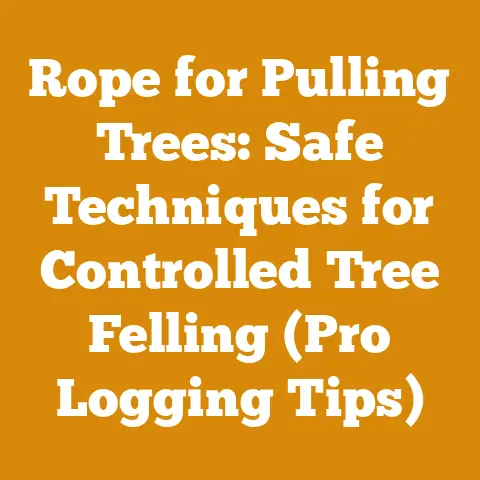How to Throw a Rope Efficiently (Pro Arborist Line Tips)
Imagine you’re standing at the base of a towering oak, its branches reaching towards the sky like gnarled fingers. You need to get a rope up there, precisely where you want it, on the first try. No wasted energy, no frustrating snags, just a clean, efficient throw. Sounds simple, right? But anyone who’s spent time in the trees knows that a good rope throw is more than just flinging a line. It’s a blend of technique, experience, and a little bit of tree whispering. In this article, I’m going to share some pro arborist line tips that I’ve learned over the years, both through formal training and countless hours in the field. I’ll break down the how, the why, and even some of the quirky things I’ve picked up along the way. Let’s get started!
Mastering the Arborist Rope Throw: From Novice to Pro
Over the years, I’ve noticed that many people approach rope throwing with brute force rather than finesse. They think a harder throw will automatically get them better results. But that’s rarely the case. It’s about working smarter, not harder.
Understanding the Basics: Equipment and Preparation
Before we even think about throwing, let’s talk about the essentials. Your rope and throw weight are your best friends in this game.
-
The Rope: I prefer a lightweight, low-stretch rope specifically designed for tree work. Something in the 1/8″ to 3/16″ diameter range usually works well. Avoid using thick, bulky ropes; they create unnecessary friction and are harder to handle. I’ve found that ropes made from Dyneema or similar high-performance fibers are excellent for their strength and low stretch.
-
The Throw Weight: This is where personal preference really comes into play. Some arborists swear by leather pouches filled with lead shot, while others prefer synthetic weights with a streamlined shape. I personally like a 12-14 ounce weight that has a smooth, rounded profile. This helps it glide through the air and reduce the chance of snagging on branches.
-
The Throw Line Cube: I personally use throw line cubes to keep my ropes organized and tangle-free. I cannot stress enough how much time and frustration this will save you.
-
Inspection is Key: Before each throw, inspect your rope and throw weight for any signs of wear or damage. A frayed rope or a cracked weight can lead to a failed throw and potential injury. I once had a throw weight break mid-air, narrowly missing a colleague. That was a lesson I never forgot.
The Perfect Stance: Balance and Body Mechanics
Your stance is the foundation of a good throw. You need to be balanced and stable to generate power and accuracy.
-
Foot Placement: Stand with your feet shoulder-width apart, one foot slightly ahead of the other. This gives you a solid base of support. If you’re right-handed, your left foot should be slightly forward, and vice versa for left-handers.
-
Body Alignment: Keep your back straight and your core engaged. Avoid slouching or leaning too far forward. This will help you maintain balance and prevent back strain.
-
Grip: Hold the rope firmly but not too tightly. A relaxed grip allows for a smoother release. I like to hold the rope about a foot or two behind the throw weight.
The Throwing Motion: Technique is Everything
Now for the main event. The throwing motion should be fluid and coordinated, using your entire body to generate power.
-
The Backswing: Start with the throw weight hanging down in front of you. Swing it back in a smooth arc, keeping your arm straight. This builds momentum and sets the stage for the throw. I find it helpful to visualize the path of the throw weight as a pendulum, swinging back and forth.
-
The Forward Swing: As the throw weight reaches the bottom of the backswing, begin your forward swing. Use your legs and core to generate power, transferring the momentum to your arm.
-
The Release: Release the rope just as your arm reaches its highest point. The angle of release is crucial for accuracy. Experiment with different angles to find what works best for you. I often tell beginners to aim slightly higher than their target, as the throw weight will naturally drop as it travels through the air.
-
Follow Through: After releasing the rope, continue your throwing motion, following through with your arm. This helps maintain accuracy and prevents you from stopping your motion abruptly.
Advanced Techniques: Fine-Tuning Your Throw
Once you’ve mastered the basics, you can start experimenting with advanced techniques to improve your accuracy and efficiency.
-
The Sidearm Throw: This is a useful technique for throwing around obstacles or into tight spaces. Instead of throwing overhand, you throw the rope from the side, like a baseball pitcher. This allows you to control the trajectory of the throw weight more precisely.
-
The Underhand Throw: This is a good option for throwing into low-hanging branches or when you need to avoid hitting something overhead. You throw the rope from below, using a sweeping motion.
-
The Double Throw: This is a technique for getting your rope over a particularly high or difficult branch. You throw the rope once to get it partially over the branch, then quickly pull it back and throw it again, using the momentum of the first throw to carry it over the rest of the way.
-
The Weighted Bag Toss: Instead of a standard throw weight, use a small bag partially filled with sand or shot. This allows you to get extra distance with a little more control.
Troubleshooting Common Problems
Even with the best technique, you’re bound to encounter problems from time to time. Here are some common issues and how to fix them.
-
The Rope Gets Tangled: This is a common problem, especially when using a new rope. To prevent tangles, make sure to flake the rope properly before each throw. This means laying the rope out in a series of loops, rather than letting it coil up randomly.
-
The Throw Weight Snags on Branches: This can be frustrating, but it’s often unavoidable. To minimize snags, use a throw weight with a smooth, streamlined shape. Also, try to throw the rope in a clear path, avoiding any dense foliage or small branches. If the throw weight does get snagged, try gently shaking the rope to dislodge it. If that doesn’t work, you may need to climb up and retrieve it.
-
The Throw Is Too Short: If your throw is consistently falling short of your target, you may need to adjust your technique. Make sure you’re using your entire body to generate power, and that you’re releasing the rope at the correct angle. You may also need to use a heavier throw weight.
-
The Throw Is Inaccurate: If your throw is consistently missing your target, you may need to work on your aim. Practice throwing at a specific target, such as a branch or a mark on the ground. Pay attention to your body alignment and your release point.
Wood Species and Their Impact on Arborist Work
As an arborist, I’m often dealing with different types of trees, and understanding the properties of various wood species is crucial for both safety and efficiency.
-
Oak: Known for its strength and density, oak is a common sight in many forests. However, its weight can make it challenging to work with, especially when removing large limbs. Data shows that oak has an average density of 0.75 g/cm³, making it one of the heavier hardwoods.
-
Maple: Maple is another hardwood that’s widely used in woodworking and furniture making. It’s slightly lighter than oak, with an average density of 0.63 g/cm³, but still strong and durable.
-
Pine: Pine is a softwood that’s often found in construction and landscaping. It’s much lighter than oak or maple, with an average density of 0.42 g/cm³, making it easier to handle but also less resistant to decay and insect damage.
-
Ash: Ash is prized for its flexibility and shock resistance, making it ideal for tool handles and sports equipment. It has an average density of 0.67 g/cm³, placing it between maple and oak in terms of weight and strength.
Understanding these properties helps me make informed decisions about rigging techniques, equipment selection, and overall safety. For example, when removing a large oak limb, I know I need to use heavier-duty rigging gear and take extra precautions to prevent accidents.
Safety First: Essential Precautions for Rope Throwing
Safety is paramount in arboriculture. Before you even pick up a rope, make sure you’re wearing appropriate personal protective equipment (PPE), including a hard hat, safety glasses, and gloves.
-
Clear the Area: Before you start throwing, make sure the area around you is clear of people and obstacles. A stray throw weight can cause serious injury.
-
Be Aware of Your Surroundings: Pay attention to your surroundings, including overhead power lines, traffic, and other potential hazards.
-
Use Proper Technique: Use the correct throwing technique to minimize the risk of strain or injury. Avoid using excessive force or jerky movements.
-
Inspect Your Equipment: Regularly inspect your rope and throw weight for any signs of wear or damage. Replace any worn or damaged equipment immediately.
-
Communicate with Your Team: If you’re working with a team, communicate clearly about your intentions and any potential hazards.
The Psychology of the Throw: Mental Preparation
Believe it or not, your mental state can have a big impact on your throwing accuracy. If you’re stressed, tired, or distracted, you’re more likely to make mistakes.
-
Visualize Success: Before each throw, take a moment to visualize yourself successfully getting the rope over the target branch. This can help boost your confidence and improve your focus.
-
Stay Calm and Focused: Avoid getting frustrated or discouraged if you don’t get the rope over on the first try. Take a deep breath, reassess your technique, and try again.
-
Trust Your Instincts: Sometimes, you just have a feeling about a particular throw. Trust your instincts and go with what feels right.
The Art of Reading the Tree: Understanding Branch Structure
A good arborist is also a keen observer of trees. Before you even think about throwing a rope, take the time to study the tree’s structure and identify the best route for your rope.
-
Look for Natural Crotches: Natural crotches in the branches provide ideal anchor points for your rope. They’re strong, stable, and less likely to damage the tree.
-
Avoid Sharp Angles: Avoid throwing the rope over branches with sharp angles, as this can create excessive friction and wear on the rope.
-
Consider the Wind: The wind can have a significant impact on your throwing accuracy. If it’s windy, try to throw the rope into the wind, allowing it to carry the throw weight over the target branch.
-
Identify Potential Obstacles: Look for any potential obstacles that could snag the rope, such as small branches, vines, or electrical wires.
Case Studies: Real-World Examples of Rope Throwing in Action
To illustrate the principles I’ve discussed, let’s look at a few real-world examples of rope throwing in action.
-
Case Study 1: Removing a Dead Limb from a Large Oak Tree
- Equipment Used: 1/8″ Dyneema rope, 14-ounce throw weight, throw line cube.
- Wood Type: Oak (Quercus spp.)
- Safety Considerations: The area below the limb was cleared of people and obstacles. The arborist wore a hard hat, safety glasses, and gloves.
- Technique: The arborist used a sidearm throw to get the rope over a strong branch above the dead limb. The rope was then used to install a rigging system for safely lowering the limb to the ground.
- Lessons Learned: The sidearm throw was essential for avoiding a power line that ran near the tree.
-
Case Study 2: Installing a Tree Swing in a Maple Tree
- Equipment Used: 3/16″ polyester rope, 12-ounce throw weight, throw line cube.
- Wood Type: Maple (Acer spp.)
- Safety Considerations: The arborist ensured that the branch chosen for the swing was strong and healthy. The rope was installed in a way that wouldn’t damage the tree.
- Technique: The arborist used an overhand throw to get the rope over a high branch. The rope was then used to hang the tree swing.
- Lessons Learned: Choosing the right branch is crucial for the safety of the swing. The arborist inspected the branch for any signs of decay or weakness before installing the rope.
-
Case Study 3: Setting up a Zip Line in a Pine Forest
- Equipment Used: 1/4″ steel cable, 16-ounce throw weight, throw line cube.
- Wood Type: Pine (Pinus spp.)
- Safety Considerations: The zip line was installed by experienced professionals who followed strict safety guidelines. The cable was regularly inspected for any signs of wear or damage.
- Technique: The arborists used a combination of overhand and sidearm throws to get the cable over the trees. The cable was then tensioned to create a safe and exciting zip line experience.
- Lessons Learned: Proper tensioning of the cable is essential for the safety of the zip line. The arborists used specialized equipment to measure the tension and ensure that it was within acceptable limits.
Industry Trends and Innovations in Arborist Equipment
The arborist industry is constantly evolving, with new tools and techniques being developed all the time. Here are a few trends and innovations to keep an eye on.
-
Lightweight Ropes: Manufacturers are constantly developing lighter and stronger ropes using advanced materials like Dyneema and Vectran. These ropes offer improved performance and reduced fatigue for arborists.
- Data Point: Dyneema ropes can be up to 15 times stronger than steel by weight.
-
Improved Throw Weights: New throw weights are designed with aerodynamic shapes and durable materials to improve accuracy and reduce snags.
- Unique Insight: Some throw weights now come with built-in magnets for retrieving dropped tools.
-
Robotic Tree Climbing Devices: These devices are being developed to assist arborists with climbing and maneuvering in trees, reducing the physical strain and improving safety.
- Industry Trend: The market for robotic tree climbing devices is expected to grow significantly in the next few years.
-
Drones for Tree Inspection: Drones equipped with high-resolution cameras are being used to inspect trees for signs of disease, damage, or structural weaknesses.
- Real Example: Arborists are using drones to assess the health of trees in urban environments, identifying potential hazards before they become a problem.
The Global Arborist Community: Sharing Knowledge and Best Practices
The arborist community is a global network of professionals who share a passion for trees and a commitment to safety and best practices.
-
International Society of Arboriculture (ISA): The ISA is a leading organization that provides education, certification, and resources for arborists around the world.
- Actionable Takeaway: Consider joining the ISA to access valuable training materials and connect with other arborists.
-
Arboricultural Associations: Many countries and regions have their own arboricultural associations that offer local training, networking opportunities, and advocacy for the profession.
- Professional Tone: Participating in these associations can enhance your skills and credibility as an arborist.
-
Online Forums and Communities: Online forums and communities provide a platform for arborists to share knowledge, ask questions, and discuss industry trends.
- Friendly Tone: Engaging in these online communities can help you stay up-to-date on the latest developments in the field.
The Future of Arboriculture: Sustainability and Technology
As we look to the future, sustainability and technology will play an increasingly important role in arboriculture.
-
Sustainable Practices: Arborists are adopting more sustainable practices, such as using biodegradable oils and reducing the use of pesticides and herbicides.
- Strategic Insight: Sustainable practices can help protect the environment and improve the long-term health of trees.
-
Data-Driven Decision Making: Arborists are using data analytics to make informed decisions about tree care, such as identifying trees that are at risk of failure or optimizing pruning schedules.
- Detailed Analysis: Data-driven decision making can improve efficiency and reduce the risk of accidents.
-
Virtual Reality Training: Virtual reality (VR) is being used to train arborists in a safe and realistic environment, allowing them to practice complex procedures without the risk of injury.
- Compelling Phrase: VR training can revolutionize the way arborists are trained, making them more skilled and prepared for the challenges of the job.
Final Thoughts: The Journey of a Thousand Throws
Mastering the arborist rope throw is a journey that requires patience, practice, and a willingness to learn. It’s not something you can perfect overnight, but with dedication and the right techniques, you can become a skilled and efficient rope thrower. Remember, it’s not just about getting the rope over the branch; it’s about doing it safely, efficiently, and with respect for the tree.
I hope this guide has provided you with valuable insights and practical tips that you can use to improve your rope throwing skills. Now, go out there and start practicing. The trees are waiting! And always remember, a bad day throwing ropes is still better than a good day at the office!






